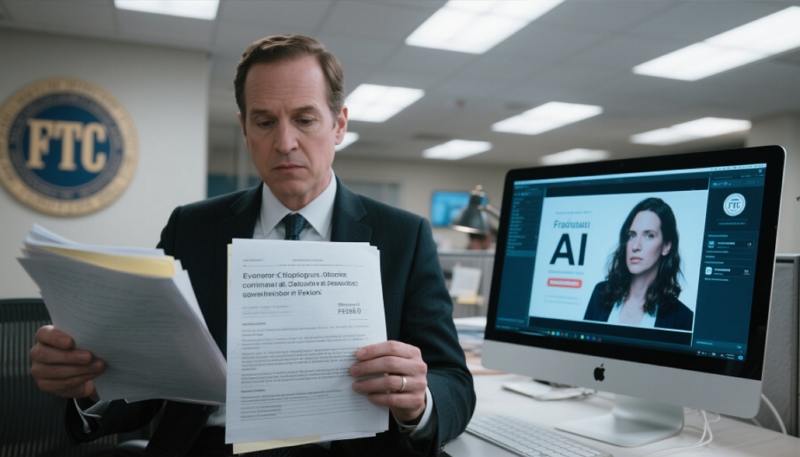Hidden Dangers of AI-Generated Product Images: False Advertising and Consumer Fraud
In the digital age, AI-generated visuals are transforming marketing with hyper-realistic product images that capture attention. However, these advancements carry hidden dangers. Without proper labeling and transparency, AI-generated images can mislead consumers into believing products perform beyond their actual capabilities, leading to false advertising and consumer fraud. This article explores a landmark 2022 FTC enforcement action, examines legal risks under U.S. and EU regulations, and presents best practices for businesses to ensure compliance.
Part 1: 2022 FTC Enforcement Action: E-Commerce Company Fined for AI-Generated Deception
In 2022, the U.S. Federal Trade Commission (FTC) cracked down on an e-commerce brand that used AI-generated images to exaggerate its products' performance. This enforcement action underscores why regulators are increasingly scrutinizing AI‐driven marketing tactics to protect consumers from deceptive imagery and inflated expectations.
1. AI-Generated Images Misrepresenting Product Capabilities
In 2022, the U.S. Federal Trade Commission (FTC) took enforcement action against an e-commerce company after discovering that it used AI-generated images to depict exaggerated product performance. Instead of showing genuine photographs, the brand's marketing materials featured digitally altered visuals, a vacuum cleaner shown picking up debris in a single pass when, in reality, it required multiple sweeps. As a result, consumers felt misled when the actual product failed to match what was advertised.

2. Violation of FTC Act Section 5: Deceptive Advertising Defined
The FTC's suit focused on Section 5 of the FTC Act, which outlaws "unfair or deceptive acts or practices." By presenting simulated product effects as real, the company violated this statute. In its complaint, the FTC emphasized that any "visual claim" implying a product performs beyond its true capabilities without disclosure and constitutes deceptive advertising. The final settlement included a financial penalty and a requirement that the company implement a compliance program to ensure future transparency.
Part 2: Legal Risks of AI-Generated Advertising Images
This section outlines the principal legal risks associated with AI‐generated advertising images, including specific requirements under U.S. FTC law and the EU Consumer Rights Directive. By understanding these obligations, marketers can avoid hefty fines, reputational damage, and potential injunctions.
1. Violation of US FTC Act Section 5: Requirements for Truthful Visual Claims
Under the FTC Act, companies must ensure that every claim-textual or visual can be substantiated. When using AI to create "before and after" product images or to showcase hypothetical scenarios, failure to label those visuals as AI-generated or simulated can lead to charges of deceptive advertising. The FTC has clarified that if a consumer could reasonably believe a simulated image reflects a real outcome, that image must include a clear disclosure (e.g., "Image simulated for illustrative purposes").
2. EU Consumer Rights Directive: Mandatory Disclosure of Simulated Product Visuals
In the European Union, the Consumer Rights Directive (2011/83/EU) requires that any marketing material not reflecting actual goods be clearly identified. For AI-generated or heavily retouched product images, the company must add phrases such as "Simulated demonstration" or "Mockup actual product may vary." Failure to comply can result in enforcement actions by EU member states' consumer protection authorities, fines, and orders to cease misleading practices.
Part 3: Best Practices for Compliance When Using AI-Generated Product Images
This section provides actionable guidelines ranging from on‐image disclosures to vendor contracts that ensure AI-generated visuals remain truthful and verifiable.
1. Labeling AI-Generated and Simulated Product Images Clearly
Overlay Text Disclosures
- Examples: "AI-generated image", "Illustrative purposes only", "Simulated product demo".
- Position the disclosure visibly, ideally in a corner of the image or immediately below, so consumers recognize it is not an actual photo.
Website and Catalog Notices
- On e-commerce pages or printed catalogs, include a banner or footnote stating: "All images are simulated; refer to product specifications for actual performance."
- This approach covers any generated visuals embedded within galleries, carousels, or print ads.

2. Maintaining Original Product Assets for Regulatory Verification
Archive Raw Photographs and Product Data
- Store unedited, high resolution originals in a secure repository (cloud or on-premise).
- Retain documentation on how AI tools were used, including version numbers, parameters, and design briefs.
Audit Trail for AI Editing Processes
- Maintain logs of every AI session or batch of images generated.
- If regulators request evidence, companies can demonstrate exactly which assets were AI altered and share corresponding originals.
3. Avoiding Fabricated Features in AI-Generated Visuals
Restrict AI Enhancements to Realistic Scenarios
- Do not show product capabilities that do not exist (e.g., a smartphone hologram projection when the phone has no hologram feature).
- If illustrating a future product or concept, label it as a "concept rendering" and clarify the product is "not yet available."
Peer Review and Legal Approval
- Before publishing, have a cross-functional team (marketing, legal, product) review AI-generated visuals to confirm they do not imply false performance.
- Develop a compliance checklist that covers every exaggerated claim, from color saturation to functional outcomes.
4. Establishing Guidelines for AI Tool Providers and Designers
Vendor Contracts with Disclosure Clauses
- When outsourcing to freelance designers or AI image services, include terms requiring clear labeling of any AI-generated content.
- Specify that the vendor must provide original files and detailed change logs.
Internal Training and Standard Operating Procedures (SOPs)
- Educate marketing and design teams on regulatory requirements (FTC guidelines, EU directives).
- Create an SOP for generating and approving AI-enhanced visuals, including template disclosures, legal sign off, and final QA steps.
Recommendation: HitPaw FotorPea for Compliant AI Image Enhancement
Navigating AI-generated visuals demands tools that simplify compliance by integrating transparency features and audit trails. HitPaw FotorPea offers businesses a streamlined solution for enhancing and generating product images while maintaining clear labeling and regulatory controls. Its intuitive interface, AI-based upscaling, and batch-processing capabilities allow marketing teams to produce high‐quality, compliant visuals that avoid deceptive representations.
- Advanced AI-based upscaling delivers clear high-resolution images without loss of detail.
- Batch processing enables simultaneous enhancement of multiple images for efficiency.
- Customizable AI models allow precise control over color, lighting, and texture realism.
- Real-time preview offers immediate comparison between original and enhanced outputs.
Step 1.Download and Install HitPaw FotorPea. Run the software and click Enhance Photos Now to import the photo you want to upscale to the software.

Step 2.Select an AI Model. Once uploaded the photo, select an AI model and click the Preview button to process the photo; you may need to wait for a few seconds.

Step 3.Preview the Effect. Review the comparison between the original and AI-enhanced image for any signs of over-exaggeration.

Step 4.Export the Enhanced Photo. Once satisfied, click Export to save the enhanced (and properly labeled) photo for publishing.
Conclusion
AI-generated product images can elevate marketing creativity, but they also pose significant risks of misleading consumers when used irresponsibly. Implementing clear labeling protocols, preserving original assets, avoiding fabricated features, and establishing robust vendor guidelines ensures transparency and compliance. Ultimately, responsible use of AI-driven visuals promotes consumer trust, reduces the risk of false advertising, and fosters a more credible marketplace.













 HitPaw Univd (Video Converter)
HitPaw Univd (Video Converter) HitPaw VoicePea
HitPaw VoicePea  HitPaw VikPea (Video Enhancer)
HitPaw VikPea (Video Enhancer)



Share this article:
Select the product rating:
Daniel Walker
Editor-in-Chief
This post was written by Editor Daniel Walker whose passion lies in bridging the gap between cutting-edge technology and everyday creativity. The content he created inspires the audience to embrace digital tools confidently.
View all ArticlesLeave a Comment
Create your review for HitPaw articles